Efficiency of Gasoline Engine with Plug-in Battery Charging - Research Practice
VerifiedAdded on 2023/04/23
|19
|4654
|328
AI Summary
The research aims to measure the efficiency of a gasoline engine with plug-in battery charging, focusing on reducing fuel consumption and emissions. The study includes a literature review, research methodology, and sub-problems related to measuring engine efficiency. The scope is limited to one particular gasoline car engine and the use of plug-in batteries. The subject is Engineering Research Practice and the document type is a dissertation. Course code, course name, and college/university are not mentioned.
Contribute Materials
Your contribution can guide someone’s learning journey. Share your
documents today.

ENGINEERING RESEARCH PRACTICE 1
Engineering research practice
By ()
The Name of the Course
Tutor
The Name of the institution
The state and the city where it’s located
The Date
Engineering research practice
By ()
The Name of the Course
Tutor
The Name of the institution
The state and the city where it’s located
The Date
Secure Best Marks with AI Grader
Need help grading? Try our AI Grader for instant feedback on your assignments.
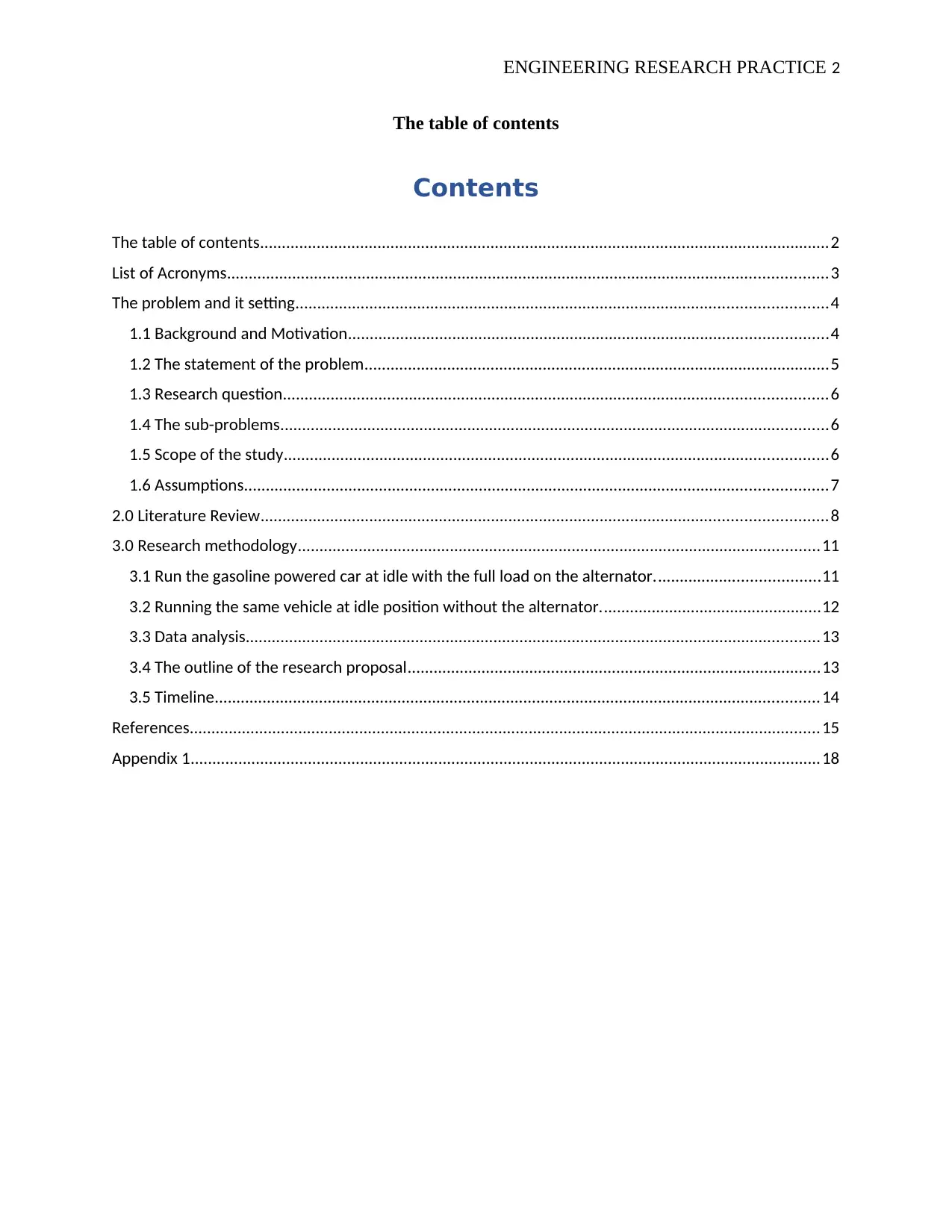
ENGINEERING RESEARCH PRACTICE 2
The table of contents
Contents
The table of contents...................................................................................................................................2
List of Acronyms..........................................................................................................................................3
The problem and it setting..........................................................................................................................4
1.1 Background and Motivation..............................................................................................................4
1.2 The statement of the problem...........................................................................................................5
1.3 Research question.............................................................................................................................6
1.4 The sub-problems..............................................................................................................................6
1.5 Scope of the study.............................................................................................................................6
1.6 Assumptions......................................................................................................................................7
2.0 Literature Review..................................................................................................................................8
3.0 Research methodology........................................................................................................................11
3.1 Run the gasoline powered car at idle with the full load on the alternator......................................11
3.2 Running the same vehicle at idle position without the alternator...................................................12
3.3 Data analysis....................................................................................................................................13
3.4 The outline of the research proposal...............................................................................................13
3.5 Timeline...........................................................................................................................................14
References.................................................................................................................................................15
Appendix 1.................................................................................................................................................18
The table of contents
Contents
The table of contents...................................................................................................................................2
List of Acronyms..........................................................................................................................................3
The problem and it setting..........................................................................................................................4
1.1 Background and Motivation..............................................................................................................4
1.2 The statement of the problem...........................................................................................................5
1.3 Research question.............................................................................................................................6
1.4 The sub-problems..............................................................................................................................6
1.5 Scope of the study.............................................................................................................................6
1.6 Assumptions......................................................................................................................................7
2.0 Literature Review..................................................................................................................................8
3.0 Research methodology........................................................................................................................11
3.1 Run the gasoline powered car at idle with the full load on the alternator......................................11
3.2 Running the same vehicle at idle position without the alternator...................................................12
3.3 Data analysis....................................................................................................................................13
3.4 The outline of the research proposal...............................................................................................13
3.5 Timeline...........................................................................................................................................14
References.................................................................................................................................................15
Appendix 1.................................................................................................................................................18
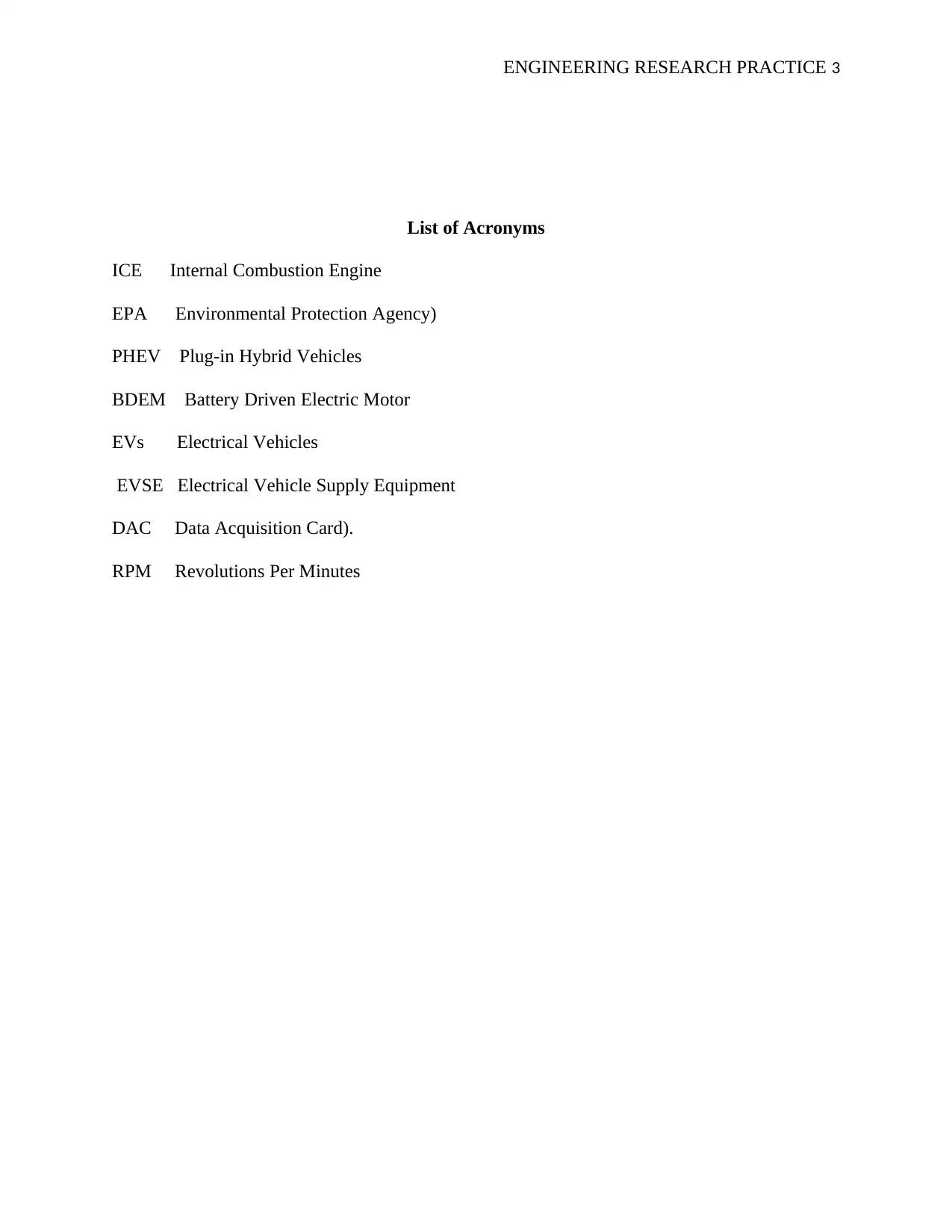
ENGINEERING RESEARCH PRACTICE 3
List of Acronyms
ICE Internal Combustion Engine
EPA Environmental Protection Agency)
PHEV Plug-in Hybrid Vehicles
BDEM Battery Driven Electric Motor
EVs Electrical Vehicles
EVSE Electrical Vehicle Supply Equipment
DAC Data Acquisition Card).
RPM Revolutions Per Minutes
List of Acronyms
ICE Internal Combustion Engine
EPA Environmental Protection Agency)
PHEV Plug-in Hybrid Vehicles
BDEM Battery Driven Electric Motor
EVs Electrical Vehicles
EVSE Electrical Vehicle Supply Equipment
DAC Data Acquisition Card).
RPM Revolutions Per Minutes
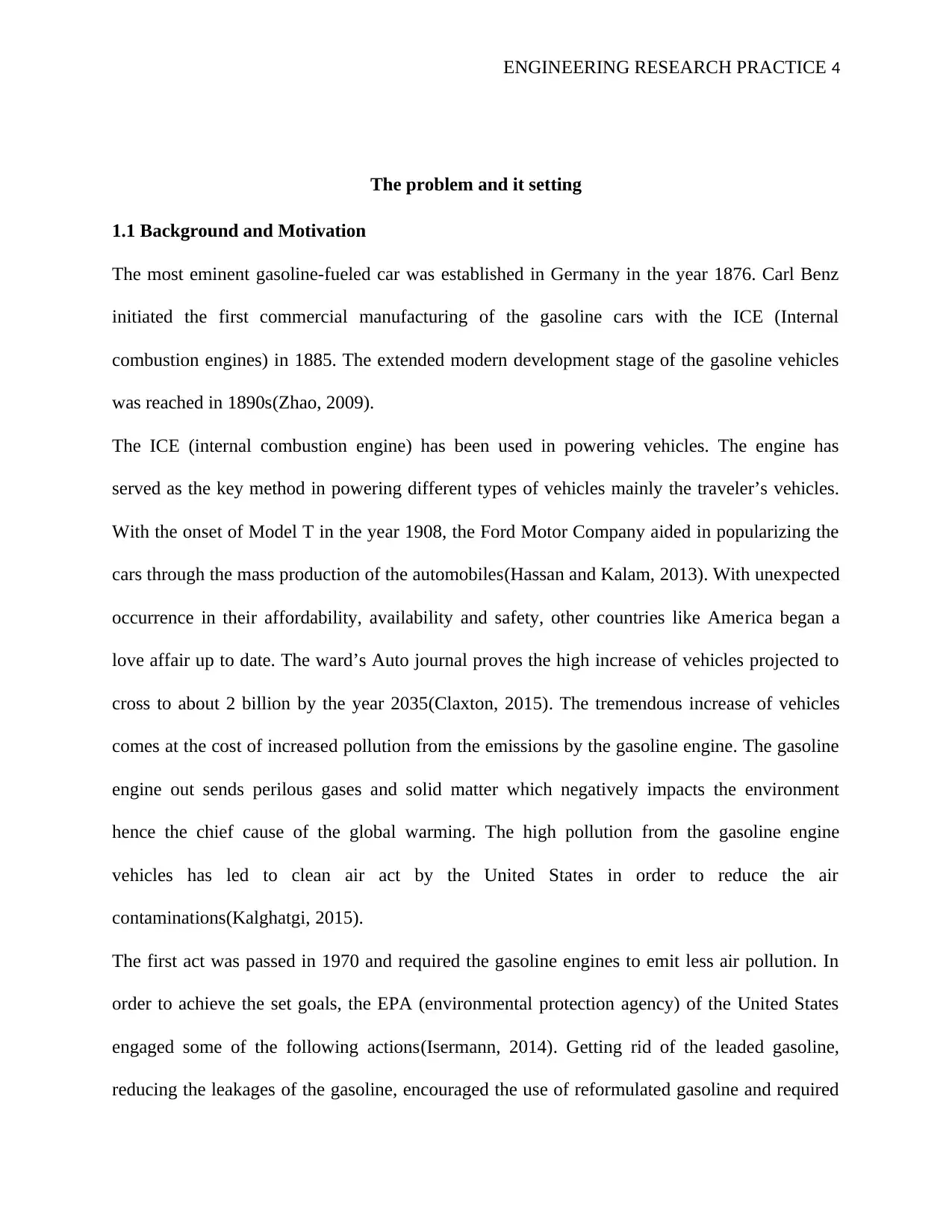
ENGINEERING RESEARCH PRACTICE 4
The problem and it setting
1.1 Background and Motivation
The most eminent gasoline-fueled car was established in Germany in the year 1876. Carl Benz
initiated the first commercial manufacturing of the gasoline cars with the ICE (Internal
combustion engines) in 1885. The extended modern development stage of the gasoline vehicles
was reached in 1890s(Zhao, 2009).
The ICE (internal combustion engine) has been used in powering vehicles. The engine has
served as the key method in powering different types of vehicles mainly the traveler’s vehicles.
With the onset of Model T in the year 1908, the Ford Motor Company aided in popularizing the
cars through the mass production of the automobiles(Hassan and Kalam, 2013). With unexpected
occurrence in their affordability, availability and safety, other countries like America began a
love affair up to date. The ward’s Auto journal proves the high increase of vehicles projected to
cross to about 2 billion by the year 2035(Claxton, 2015). The tremendous increase of vehicles
comes at the cost of increased pollution from the emissions by the gasoline engine. The gasoline
engine out sends perilous gases and solid matter which negatively impacts the environment
hence the chief cause of the global warming. The high pollution from the gasoline engine
vehicles has led to clean air act by the United States in order to reduce the air
contaminations(Kalghatgi, 2015).
The first act was passed in 1970 and required the gasoline engines to emit less air pollution. In
order to achieve the set goals, the EPA (environmental protection agency) of the United States
engaged some of the following actions(Isermann, 2014). Getting rid of the leaded gasoline,
reducing the leakages of the gasoline, encouraged the use of reformulated gasoline and required
The problem and it setting
1.1 Background and Motivation
The most eminent gasoline-fueled car was established in Germany in the year 1876. Carl Benz
initiated the first commercial manufacturing of the gasoline cars with the ICE (Internal
combustion engines) in 1885. The extended modern development stage of the gasoline vehicles
was reached in 1890s(Zhao, 2009).
The ICE (internal combustion engine) has been used in powering vehicles. The engine has
served as the key method in powering different types of vehicles mainly the traveler’s vehicles.
With the onset of Model T in the year 1908, the Ford Motor Company aided in popularizing the
cars through the mass production of the automobiles(Hassan and Kalam, 2013). With unexpected
occurrence in their affordability, availability and safety, other countries like America began a
love affair up to date. The ward’s Auto journal proves the high increase of vehicles projected to
cross to about 2 billion by the year 2035(Claxton, 2015). The tremendous increase of vehicles
comes at the cost of increased pollution from the emissions by the gasoline engine. The gasoline
engine out sends perilous gases and solid matter which negatively impacts the environment
hence the chief cause of the global warming. The high pollution from the gasoline engine
vehicles has led to clean air act by the United States in order to reduce the air
contaminations(Kalghatgi, 2015).
The first act was passed in 1970 and required the gasoline engines to emit less air pollution. In
order to achieve the set goals, the EPA (environmental protection agency) of the United States
engaged some of the following actions(Isermann, 2014). Getting rid of the leaded gasoline,
reducing the leakages of the gasoline, encouraged the use of reformulated gasoline and required
Secure Best Marks with AI Grader
Need help grading? Try our AI Grader for instant feedback on your assignments.
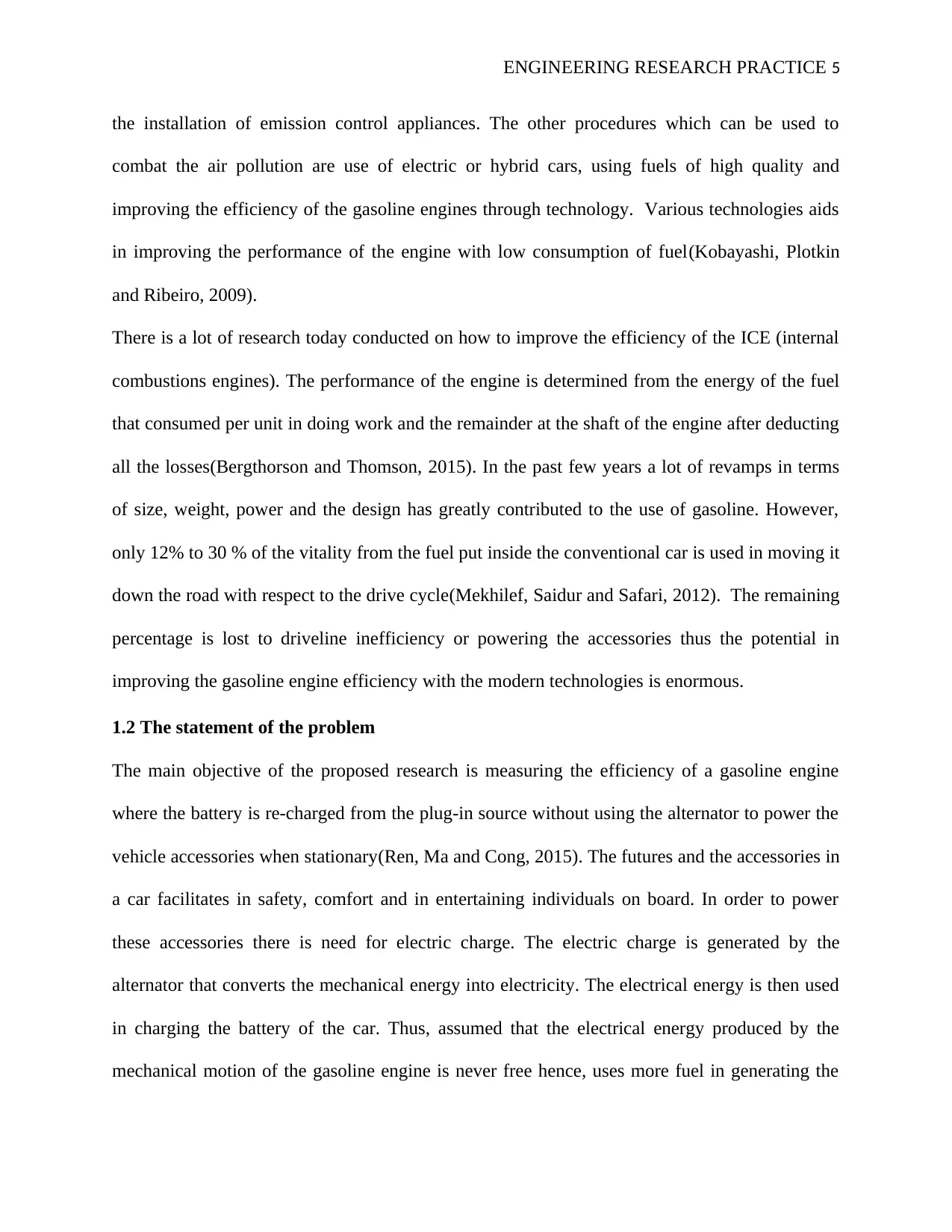
ENGINEERING RESEARCH PRACTICE 5
the installation of emission control appliances. The other procedures which can be used to
combat the air pollution are use of electric or hybrid cars, using fuels of high quality and
improving the efficiency of the gasoline engines through technology. Various technologies aids
in improving the performance of the engine with low consumption of fuel(Kobayashi, Plotkin
and Ribeiro, 2009).
There is a lot of research today conducted on how to improve the efficiency of the ICE (internal
combustions engines). The performance of the engine is determined from the energy of the fuel
that consumed per unit in doing work and the remainder at the shaft of the engine after deducting
all the losses(Bergthorson and Thomson, 2015). In the past few years a lot of revamps in terms
of size, weight, power and the design has greatly contributed to the use of gasoline. However,
only 12% to 30 % of the vitality from the fuel put inside the conventional car is used in moving it
down the road with respect to the drive cycle(Mekhilef, Saidur and Safari, 2012). The remaining
percentage is lost to driveline inefficiency or powering the accessories thus the potential in
improving the gasoline engine efficiency with the modern technologies is enormous.
1.2 The statement of the problem
The main objective of the proposed research is measuring the efficiency of a gasoline engine
where the battery is re-charged from the plug-in source without using the alternator to power the
vehicle accessories when stationary(Ren, Ma and Cong, 2015). The futures and the accessories in
a car facilitates in safety, comfort and in entertaining individuals on board. In order to power
these accessories there is need for electric charge. The electric charge is generated by the
alternator that converts the mechanical energy into electricity. The electrical energy is then used
in charging the battery of the car. Thus, assumed that the electrical energy produced by the
mechanical motion of the gasoline engine is never free hence, uses more fuel in generating the
the installation of emission control appliances. The other procedures which can be used to
combat the air pollution are use of electric or hybrid cars, using fuels of high quality and
improving the efficiency of the gasoline engines through technology. Various technologies aids
in improving the performance of the engine with low consumption of fuel(Kobayashi, Plotkin
and Ribeiro, 2009).
There is a lot of research today conducted on how to improve the efficiency of the ICE (internal
combustions engines). The performance of the engine is determined from the energy of the fuel
that consumed per unit in doing work and the remainder at the shaft of the engine after deducting
all the losses(Bergthorson and Thomson, 2015). In the past few years a lot of revamps in terms
of size, weight, power and the design has greatly contributed to the use of gasoline. However,
only 12% to 30 % of the vitality from the fuel put inside the conventional car is used in moving it
down the road with respect to the drive cycle(Mekhilef, Saidur and Safari, 2012). The remaining
percentage is lost to driveline inefficiency or powering the accessories thus the potential in
improving the gasoline engine efficiency with the modern technologies is enormous.
1.2 The statement of the problem
The main objective of the proposed research is measuring the efficiency of a gasoline engine
where the battery is re-charged from the plug-in source without using the alternator to power the
vehicle accessories when stationary(Ren, Ma and Cong, 2015). The futures and the accessories in
a car facilitates in safety, comfort and in entertaining individuals on board. In order to power
these accessories there is need for electric charge. The electric charge is generated by the
alternator that converts the mechanical energy into electricity. The electrical energy is then used
in charging the battery of the car. Thus, assumed that the electrical energy produced by the
mechanical motion of the gasoline engine is never free hence, uses more fuel in generating the
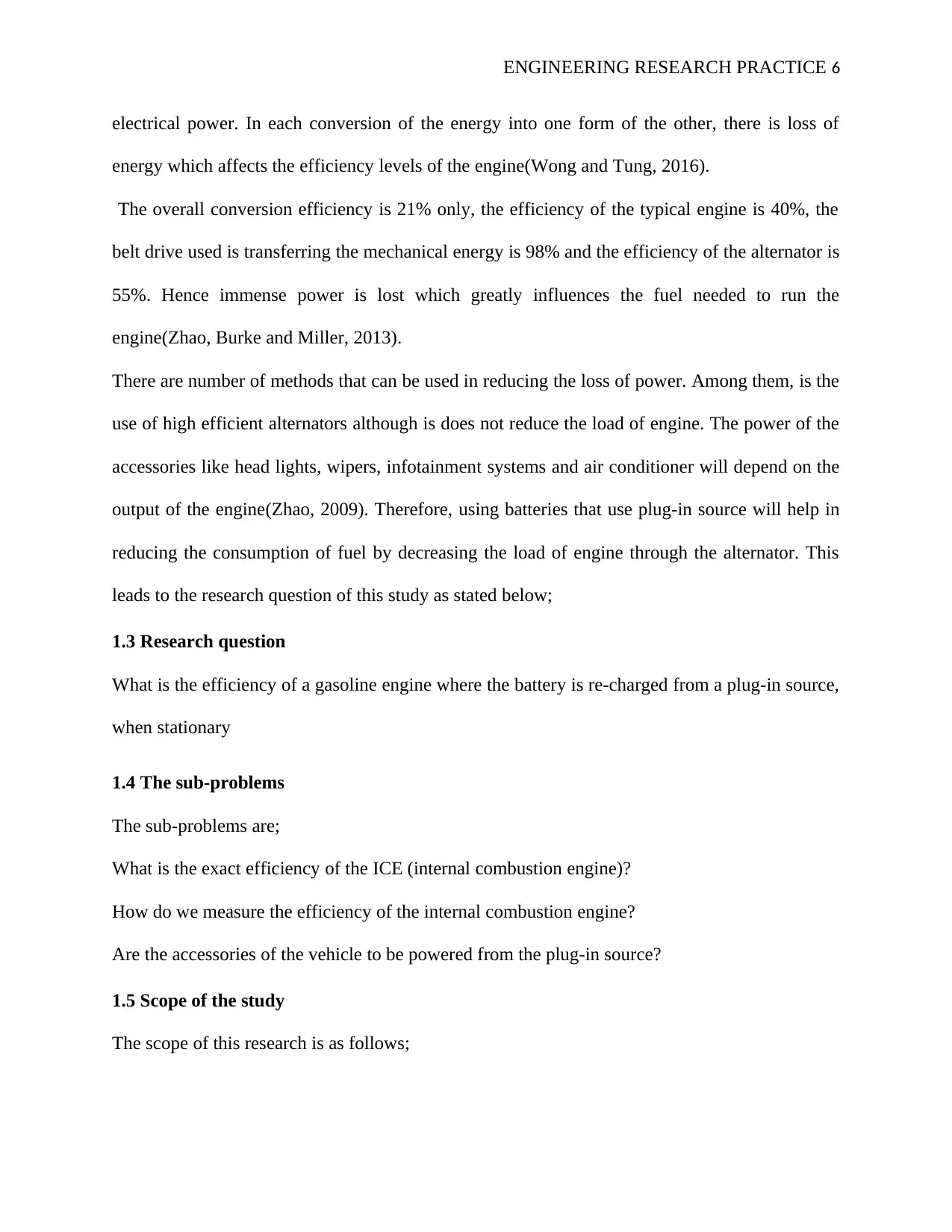
ENGINEERING RESEARCH PRACTICE 6
electrical power. In each conversion of the energy into one form of the other, there is loss of
energy which affects the efficiency levels of the engine(Wong and Tung, 2016).
The overall conversion efficiency is 21% only, the efficiency of the typical engine is 40%, the
belt drive used is transferring the mechanical energy is 98% and the efficiency of the alternator is
55%. Hence immense power is lost which greatly influences the fuel needed to run the
engine(Zhao, Burke and Miller, 2013).
There are number of methods that can be used in reducing the loss of power. Among them, is the
use of high efficient alternators although is does not reduce the load of engine. The power of the
accessories like head lights, wipers, infotainment systems and air conditioner will depend on the
output of the engine(Zhao, 2009). Therefore, using batteries that use plug-in source will help in
reducing the consumption of fuel by decreasing the load of engine through the alternator. This
leads to the research question of this study as stated below;
1.3 Research question
What is the efficiency of a gasoline engine where the battery is re-charged from a plug-in source,
when stationary
1.4 The sub-problems
The sub-problems are;
What is the exact efficiency of the ICE (internal combustion engine)?
How do we measure the efficiency of the internal combustion engine?
Are the accessories of the vehicle to be powered from the plug-in source?
1.5 Scope of the study
The scope of this research is as follows;
electrical power. In each conversion of the energy into one form of the other, there is loss of
energy which affects the efficiency levels of the engine(Wong and Tung, 2016).
The overall conversion efficiency is 21% only, the efficiency of the typical engine is 40%, the
belt drive used is transferring the mechanical energy is 98% and the efficiency of the alternator is
55%. Hence immense power is lost which greatly influences the fuel needed to run the
engine(Zhao, Burke and Miller, 2013).
There are number of methods that can be used in reducing the loss of power. Among them, is the
use of high efficient alternators although is does not reduce the load of engine. The power of the
accessories like head lights, wipers, infotainment systems and air conditioner will depend on the
output of the engine(Zhao, 2009). Therefore, using batteries that use plug-in source will help in
reducing the consumption of fuel by decreasing the load of engine through the alternator. This
leads to the research question of this study as stated below;
1.3 Research question
What is the efficiency of a gasoline engine where the battery is re-charged from a plug-in source,
when stationary
1.4 The sub-problems
The sub-problems are;
What is the exact efficiency of the ICE (internal combustion engine)?
How do we measure the efficiency of the internal combustion engine?
Are the accessories of the vehicle to be powered from the plug-in source?
1.5 Scope of the study
The scope of this research is as follows;

ENGINEERING RESEARCH PRACTICE 7
1. This research will only involve determining the efficiency of the internal gasoline engine
of a car whose battery is charged from the plug-in source.
2. The design will focus to one particular gasoline car engine.
3. The design will measure both the efficiency of the internal combustion engine whose
battery is charged from the alternator as well as the efficiency of the internal combustion
engine whose battery is charged from the plug-in source.
1.6 Assumptions
The electrical energy generated by the mechanical motion of the gasoline engine is never free.
There is loss of energy during the conversion of energy from one form to another.
The energy that is lost directly affect the efficiency of the gasoline engine.
1. This research will only involve determining the efficiency of the internal gasoline engine
of a car whose battery is charged from the plug-in source.
2. The design will focus to one particular gasoline car engine.
3. The design will measure both the efficiency of the internal combustion engine whose
battery is charged from the alternator as well as the efficiency of the internal combustion
engine whose battery is charged from the plug-in source.
1.6 Assumptions
The electrical energy generated by the mechanical motion of the gasoline engine is never free.
There is loss of energy during the conversion of energy from one form to another.
The energy that is lost directly affect the efficiency of the gasoline engine.
Paraphrase This Document
Need a fresh take? Get an instant paraphrase of this document with our AI Paraphraser
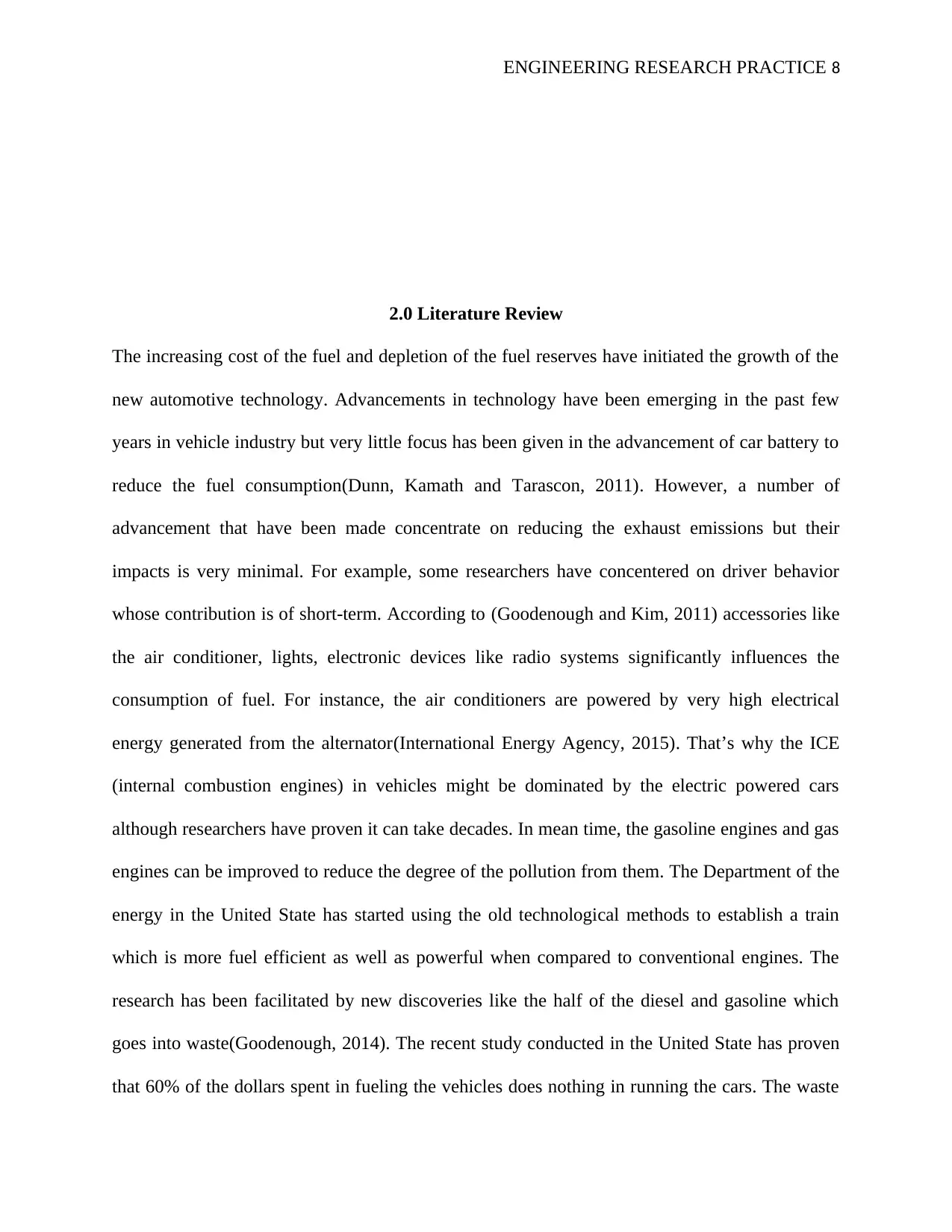
ENGINEERING RESEARCH PRACTICE 8
2.0 Literature Review
The increasing cost of the fuel and depletion of the fuel reserves have initiated the growth of the
new automotive technology. Advancements in technology have been emerging in the past few
years in vehicle industry but very little focus has been given in the advancement of car battery to
reduce the fuel consumption(Dunn, Kamath and Tarascon, 2011). However, a number of
advancement that have been made concentrate on reducing the exhaust emissions but their
impacts is very minimal. For example, some researchers have concentered on driver behavior
whose contribution is of short-term. According to (Goodenough and Kim, 2011) accessories like
the air conditioner, lights, electronic devices like radio systems significantly influences the
consumption of fuel. For instance, the air conditioners are powered by very high electrical
energy generated from the alternator(International Energy Agency, 2015). That’s why the ICE
(internal combustion engines) in vehicles might be dominated by the electric powered cars
although researchers have proven it can take decades. In mean time, the gasoline engines and gas
engines can be improved to reduce the degree of the pollution from them. The Department of the
energy in the United State has started using the old technological methods to establish a train
which is more fuel efficient as well as powerful when compared to conventional engines. The
research has been facilitated by new discoveries like the half of the diesel and gasoline which
goes into waste(Goodenough, 2014). The recent study conducted in the United State has proven
that 60% of the dollars spent in fueling the vehicles does nothing in running the cars. The waste
2.0 Literature Review
The increasing cost of the fuel and depletion of the fuel reserves have initiated the growth of the
new automotive technology. Advancements in technology have been emerging in the past few
years in vehicle industry but very little focus has been given in the advancement of car battery to
reduce the fuel consumption(Dunn, Kamath and Tarascon, 2011). However, a number of
advancement that have been made concentrate on reducing the exhaust emissions but their
impacts is very minimal. For example, some researchers have concentered on driver behavior
whose contribution is of short-term. According to (Goodenough and Kim, 2011) accessories like
the air conditioner, lights, electronic devices like radio systems significantly influences the
consumption of fuel. For instance, the air conditioners are powered by very high electrical
energy generated from the alternator(International Energy Agency, 2015). That’s why the ICE
(internal combustion engines) in vehicles might be dominated by the electric powered cars
although researchers have proven it can take decades. In mean time, the gasoline engines and gas
engines can be improved to reduce the degree of the pollution from them. The Department of the
energy in the United State has started using the old technological methods to establish a train
which is more fuel efficient as well as powerful when compared to conventional engines. The
research has been facilitated by new discoveries like the half of the diesel and gasoline which
goes into waste(Goodenough, 2014). The recent study conducted in the United State has proven
that 60% of the dollars spent in fueling the vehicles does nothing in running the cars. The waste
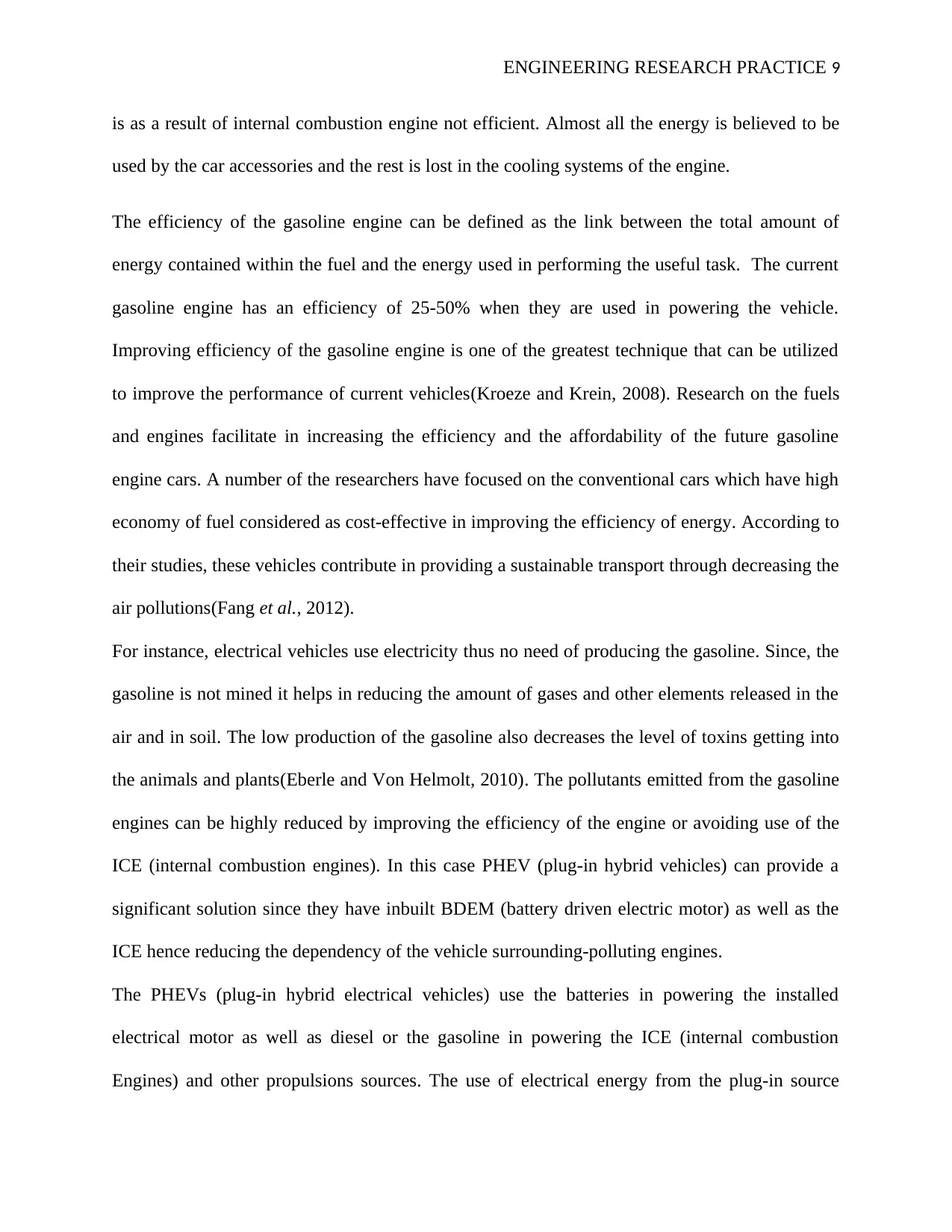
ENGINEERING RESEARCH PRACTICE 9
is as a result of internal combustion engine not efficient. Almost all the energy is believed to be
used by the car accessories and the rest is lost in the cooling systems of the engine.
The efficiency of the gasoline engine can be defined as the link between the total amount of
energy contained within the fuel and the energy used in performing the useful task. The current
gasoline engine has an efficiency of 25-50% when they are used in powering the vehicle.
Improving efficiency of the gasoline engine is one of the greatest technique that can be utilized
to improve the performance of current vehicles(Kroeze and Krein, 2008). Research on the fuels
and engines facilitate in increasing the efficiency and the affordability of the future gasoline
engine cars. A number of the researchers have focused on the conventional cars which have high
economy of fuel considered as cost-effective in improving the efficiency of energy. According to
their studies, these vehicles contribute in providing a sustainable transport through decreasing the
air pollutions(Fang et al., 2012).
For instance, electrical vehicles use electricity thus no need of producing the gasoline. Since, the
gasoline is not mined it helps in reducing the amount of gases and other elements released in the
air and in soil. The low production of the gasoline also decreases the level of toxins getting into
the animals and plants(Eberle and Von Helmolt, 2010). The pollutants emitted from the gasoline
engines can be highly reduced by improving the efficiency of the engine or avoiding use of the
ICE (internal combustion engines). In this case PHEV (plug-in hybrid vehicles) can provide a
significant solution since they have inbuilt BDEM (battery driven electric motor) as well as the
ICE hence reducing the dependency of the vehicle surrounding-polluting engines.
The PHEVs (plug-in hybrid electrical vehicles) use the batteries in powering the installed
electrical motor as well as diesel or the gasoline in powering the ICE (internal combustion
Engines) and other propulsions sources. The use of electrical energy from the plug-in source
is as a result of internal combustion engine not efficient. Almost all the energy is believed to be
used by the car accessories and the rest is lost in the cooling systems of the engine.
The efficiency of the gasoline engine can be defined as the link between the total amount of
energy contained within the fuel and the energy used in performing the useful task. The current
gasoline engine has an efficiency of 25-50% when they are used in powering the vehicle.
Improving efficiency of the gasoline engine is one of the greatest technique that can be utilized
to improve the performance of current vehicles(Kroeze and Krein, 2008). Research on the fuels
and engines facilitate in increasing the efficiency and the affordability of the future gasoline
engine cars. A number of the researchers have focused on the conventional cars which have high
economy of fuel considered as cost-effective in improving the efficiency of energy. According to
their studies, these vehicles contribute in providing a sustainable transport through decreasing the
air pollutions(Fang et al., 2012).
For instance, electrical vehicles use electricity thus no need of producing the gasoline. Since, the
gasoline is not mined it helps in reducing the amount of gases and other elements released in the
air and in soil. The low production of the gasoline also decreases the level of toxins getting into
the animals and plants(Eberle and Von Helmolt, 2010). The pollutants emitted from the gasoline
engines can be highly reduced by improving the efficiency of the engine or avoiding use of the
ICE (internal combustion engines). In this case PHEV (plug-in hybrid vehicles) can provide a
significant solution since they have inbuilt BDEM (battery driven electric motor) as well as the
ICE hence reducing the dependency of the vehicle surrounding-polluting engines.
The PHEVs (plug-in hybrid electrical vehicles) use the batteries in powering the installed
electrical motor as well as diesel or the gasoline in powering the ICE (internal combustion
Engines) and other propulsions sources. The use of electrical energy from the plug-in source
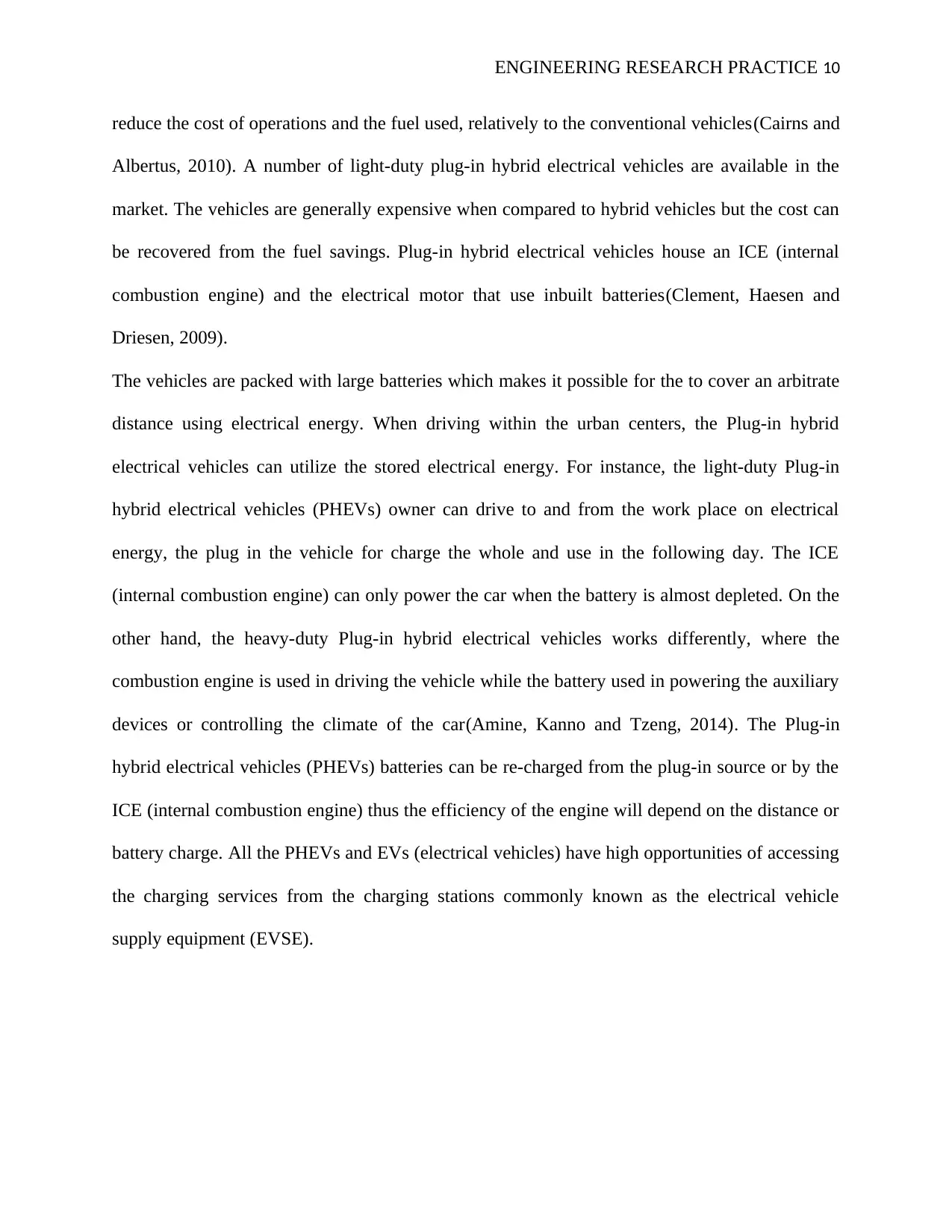
ENGINEERING RESEARCH PRACTICE 10
reduce the cost of operations and the fuel used, relatively to the conventional vehicles(Cairns and
Albertus, 2010). A number of light-duty plug-in hybrid electrical vehicles are available in the
market. The vehicles are generally expensive when compared to hybrid vehicles but the cost can
be recovered from the fuel savings. Plug-in hybrid electrical vehicles house an ICE (internal
combustion engine) and the electrical motor that use inbuilt batteries(Clement, Haesen and
Driesen, 2009).
The vehicles are packed with large batteries which makes it possible for the to cover an arbitrate
distance using electrical energy. When driving within the urban centers, the Plug-in hybrid
electrical vehicles can utilize the stored electrical energy. For instance, the light-duty Plug-in
hybrid electrical vehicles (PHEVs) owner can drive to and from the work place on electrical
energy, the plug in the vehicle for charge the whole and use in the following day. The ICE
(internal combustion engine) can only power the car when the battery is almost depleted. On the
other hand, the heavy-duty Plug-in hybrid electrical vehicles works differently, where the
combustion engine is used in driving the vehicle while the battery used in powering the auxiliary
devices or controlling the climate of the car(Amine, Kanno and Tzeng, 2014). The Plug-in
hybrid electrical vehicles (PHEVs) batteries can be re-charged from the plug-in source or by the
ICE (internal combustion engine) thus the efficiency of the engine will depend on the distance or
battery charge. All the PHEVs and EVs (electrical vehicles) have high opportunities of accessing
the charging services from the charging stations commonly known as the electrical vehicle
supply equipment (EVSE).
reduce the cost of operations and the fuel used, relatively to the conventional vehicles(Cairns and
Albertus, 2010). A number of light-duty plug-in hybrid electrical vehicles are available in the
market. The vehicles are generally expensive when compared to hybrid vehicles but the cost can
be recovered from the fuel savings. Plug-in hybrid electrical vehicles house an ICE (internal
combustion engine) and the electrical motor that use inbuilt batteries(Clement, Haesen and
Driesen, 2009).
The vehicles are packed with large batteries which makes it possible for the to cover an arbitrate
distance using electrical energy. When driving within the urban centers, the Plug-in hybrid
electrical vehicles can utilize the stored electrical energy. For instance, the light-duty Plug-in
hybrid electrical vehicles (PHEVs) owner can drive to and from the work place on electrical
energy, the plug in the vehicle for charge the whole and use in the following day. The ICE
(internal combustion engine) can only power the car when the battery is almost depleted. On the
other hand, the heavy-duty Plug-in hybrid electrical vehicles works differently, where the
combustion engine is used in driving the vehicle while the battery used in powering the auxiliary
devices or controlling the climate of the car(Amine, Kanno and Tzeng, 2014). The Plug-in
hybrid electrical vehicles (PHEVs) batteries can be re-charged from the plug-in source or by the
ICE (internal combustion engine) thus the efficiency of the engine will depend on the distance or
battery charge. All the PHEVs and EVs (electrical vehicles) have high opportunities of accessing
the charging services from the charging stations commonly known as the electrical vehicle
supply equipment (EVSE).
Secure Best Marks with AI Grader
Need help grading? Try our AI Grader for instant feedback on your assignments.

ENGINEERING RESEARCH PRACTICE 11
3.0 Research methodology
In order to have clear quantitative data, there will be need of testing the vehicle in the laboratory.
It might be very challenging to drive every type of the vehicle on the road in order to measure
the rate of its fuel consumption. The testing method is not suitable since it can duplicate the
results since a number of variable can impact the efficiency of the vehicle engine. This is the
reason why am choosing controlled laboratory testing in generating the fuel consumption results.
The variables to be tested are as follows;
3.1 Run the gasoline powered car at idle with the full load on the alternator.
The mechanical appliances and the framework for testing which will be the control system shall
be developed. The LabVIEW software will be used in designing the control system because its
appropriate for real-time control application(Dwivedi, Jain and Sharma, 2011). The operating
data of the engine such as load, temperature, fuel consumption and speed will be transferred to
the computer through data acquisition card in real-time. The throttle of the gasoline engine has
been controlled by the servomotor and application of the voltage to the setting input to control
the load of the dynamotor(Curley, 2011). The fuel consumption of the gasoline engine will be
measured through the load cell with an accuracy of 0.1g and then connected to the fuel tank. The
weight of the fuel tank will be read in the start of the test and at final stage of the experiment.
The two weights will be divided by the total test to obtain the instantaneous amount of the fuel
consumed. The servomotor will control the throttle while the servomotor will be controlled by
the digital DAC (Data acquisition Card)(Kara Togun and Baysec, 2010).
3.0 Research methodology
In order to have clear quantitative data, there will be need of testing the vehicle in the laboratory.
It might be very challenging to drive every type of the vehicle on the road in order to measure
the rate of its fuel consumption. The testing method is not suitable since it can duplicate the
results since a number of variable can impact the efficiency of the vehicle engine. This is the
reason why am choosing controlled laboratory testing in generating the fuel consumption results.
The variables to be tested are as follows;
3.1 Run the gasoline powered car at idle with the full load on the alternator.
The mechanical appliances and the framework for testing which will be the control system shall
be developed. The LabVIEW software will be used in designing the control system because its
appropriate for real-time control application(Dwivedi, Jain and Sharma, 2011). The operating
data of the engine such as load, temperature, fuel consumption and speed will be transferred to
the computer through data acquisition card in real-time. The throttle of the gasoline engine has
been controlled by the servomotor and application of the voltage to the setting input to control
the load of the dynamotor(Curley, 2011). The fuel consumption of the gasoline engine will be
measured through the load cell with an accuracy of 0.1g and then connected to the fuel tank. The
weight of the fuel tank will be read in the start of the test and at final stage of the experiment.
The two weights will be divided by the total test to obtain the instantaneous amount of the fuel
consumed. The servomotor will control the throttle while the servomotor will be controlled by
the digital DAC (Data acquisition Card)(Kara Togun and Baysec, 2010).
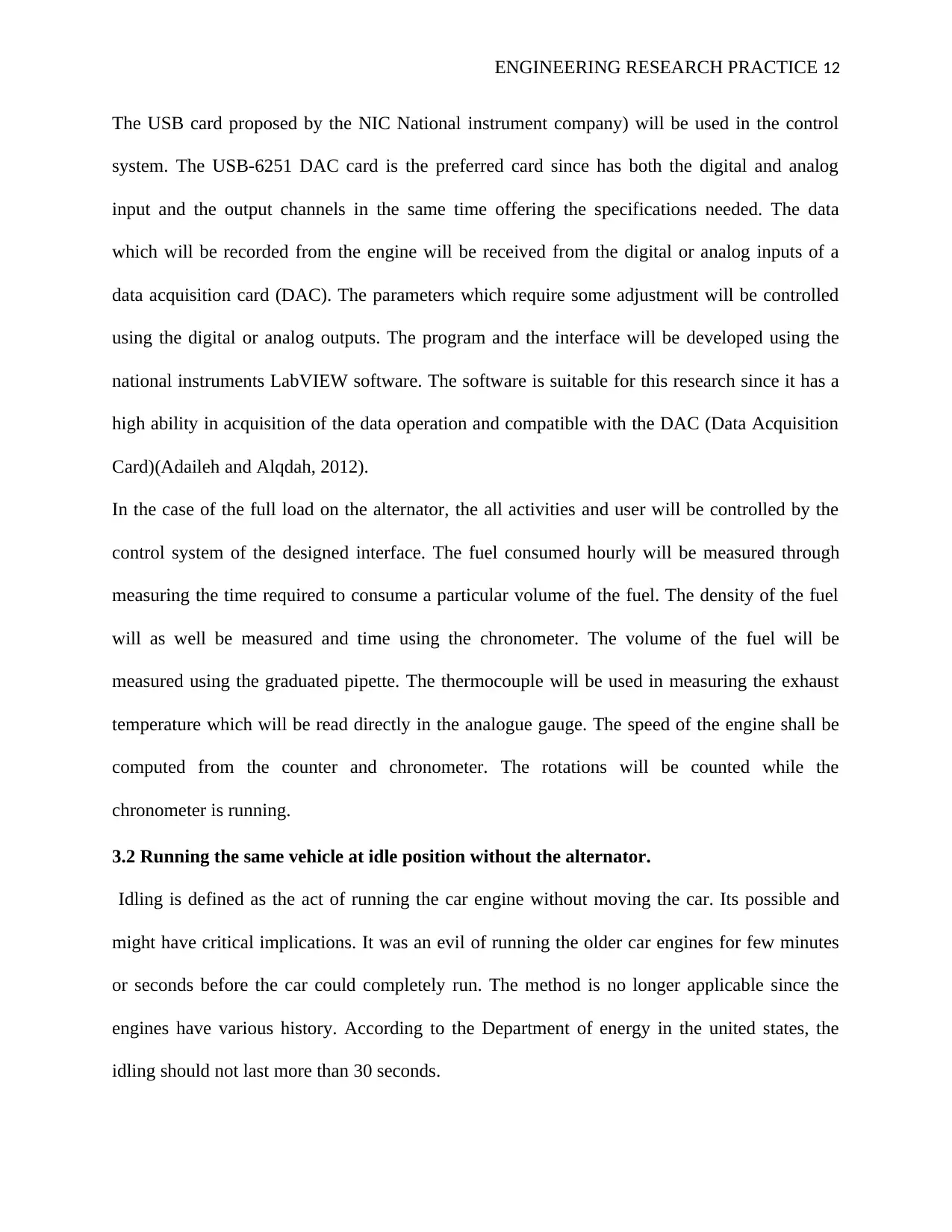
ENGINEERING RESEARCH PRACTICE 12
The USB card proposed by the NIC National instrument company) will be used in the control
system. The USB-6251 DAC card is the preferred card since has both the digital and analog
input and the output channels in the same time offering the specifications needed. The data
which will be recorded from the engine will be received from the digital or analog inputs of a
data acquisition card (DAC). The parameters which require some adjustment will be controlled
using the digital or analog outputs. The program and the interface will be developed using the
national instruments LabVIEW software. The software is suitable for this research since it has a
high ability in acquisition of the data operation and compatible with the DAC (Data Acquisition
Card)(Adaileh and Alqdah, 2012).
In the case of the full load on the alternator, the all activities and user will be controlled by the
control system of the designed interface. The fuel consumed hourly will be measured through
measuring the time required to consume a particular volume of the fuel. The density of the fuel
will as well be measured and time using the chronometer. The volume of the fuel will be
measured using the graduated pipette. The thermocouple will be used in measuring the exhaust
temperature which will be read directly in the analogue gauge. The speed of the engine shall be
computed from the counter and chronometer. The rotations will be counted while the
chronometer is running.
3.2 Running the same vehicle at idle position without the alternator.
Idling is defined as the act of running the car engine without moving the car. Its possible and
might have critical implications. It was an evil of running the older car engines for few minutes
or seconds before the car could completely run. The method is no longer applicable since the
engines have various history. According to the Department of energy in the united states, the
idling should not last more than 30 seconds.
The USB card proposed by the NIC National instrument company) will be used in the control
system. The USB-6251 DAC card is the preferred card since has both the digital and analog
input and the output channels in the same time offering the specifications needed. The data
which will be recorded from the engine will be received from the digital or analog inputs of a
data acquisition card (DAC). The parameters which require some adjustment will be controlled
using the digital or analog outputs. The program and the interface will be developed using the
national instruments LabVIEW software. The software is suitable for this research since it has a
high ability in acquisition of the data operation and compatible with the DAC (Data Acquisition
Card)(Adaileh and Alqdah, 2012).
In the case of the full load on the alternator, the all activities and user will be controlled by the
control system of the designed interface. The fuel consumed hourly will be measured through
measuring the time required to consume a particular volume of the fuel. The density of the fuel
will as well be measured and time using the chronometer. The volume of the fuel will be
measured using the graduated pipette. The thermocouple will be used in measuring the exhaust
temperature which will be read directly in the analogue gauge. The speed of the engine shall be
computed from the counter and chronometer. The rotations will be counted while the
chronometer is running.
3.2 Running the same vehicle at idle position without the alternator.
Idling is defined as the act of running the car engine without moving the car. Its possible and
might have critical implications. It was an evil of running the older car engines for few minutes
or seconds before the car could completely run. The method is no longer applicable since the
engines have various history. According to the Department of energy in the united states, the
idling should not last more than 30 seconds.
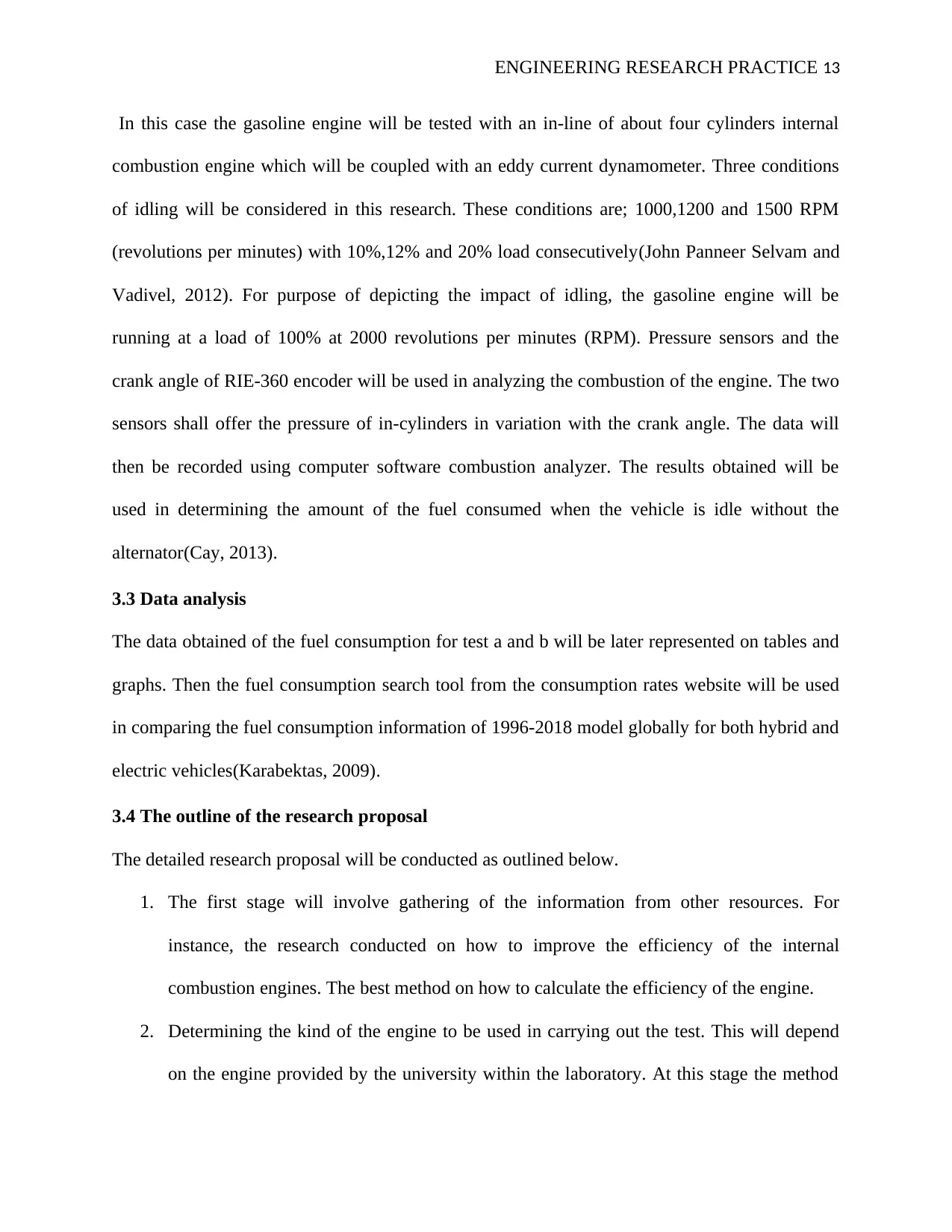
ENGINEERING RESEARCH PRACTICE 13
In this case the gasoline engine will be tested with an in-line of about four cylinders internal
combustion engine which will be coupled with an eddy current dynamometer. Three conditions
of idling will be considered in this research. These conditions are; 1000,1200 and 1500 RPM
(revolutions per minutes) with 10%,12% and 20% load consecutively(John Panneer Selvam and
Vadivel, 2012). For purpose of depicting the impact of idling, the gasoline engine will be
running at a load of 100% at 2000 revolutions per minutes (RPM). Pressure sensors and the
crank angle of RIE-360 encoder will be used in analyzing the combustion of the engine. The two
sensors shall offer the pressure of in-cylinders in variation with the crank angle. The data will
then be recorded using computer software combustion analyzer. The results obtained will be
used in determining the amount of the fuel consumed when the vehicle is idle without the
alternator(Cay, 2013).
3.3 Data analysis
The data obtained of the fuel consumption for test a and b will be later represented on tables and
graphs. Then the fuel consumption search tool from the consumption rates website will be used
in comparing the fuel consumption information of 1996-2018 model globally for both hybrid and
electric vehicles(Karabektas, 2009).
3.4 The outline of the research proposal
The detailed research proposal will be conducted as outlined below.
1. The first stage will involve gathering of the information from other resources. For
instance, the research conducted on how to improve the efficiency of the internal
combustion engines. The best method on how to calculate the efficiency of the engine.
2. Determining the kind of the engine to be used in carrying out the test. This will depend
on the engine provided by the university within the laboratory. At this stage the method
In this case the gasoline engine will be tested with an in-line of about four cylinders internal
combustion engine which will be coupled with an eddy current dynamometer. Three conditions
of idling will be considered in this research. These conditions are; 1000,1200 and 1500 RPM
(revolutions per minutes) with 10%,12% and 20% load consecutively(John Panneer Selvam and
Vadivel, 2012). For purpose of depicting the impact of idling, the gasoline engine will be
running at a load of 100% at 2000 revolutions per minutes (RPM). Pressure sensors and the
crank angle of RIE-360 encoder will be used in analyzing the combustion of the engine. The two
sensors shall offer the pressure of in-cylinders in variation with the crank angle. The data will
then be recorded using computer software combustion analyzer. The results obtained will be
used in determining the amount of the fuel consumed when the vehicle is idle without the
alternator(Cay, 2013).
3.3 Data analysis
The data obtained of the fuel consumption for test a and b will be later represented on tables and
graphs. Then the fuel consumption search tool from the consumption rates website will be used
in comparing the fuel consumption information of 1996-2018 model globally for both hybrid and
electric vehicles(Karabektas, 2009).
3.4 The outline of the research proposal
The detailed research proposal will be conducted as outlined below.
1. The first stage will involve gathering of the information from other resources. For
instance, the research conducted on how to improve the efficiency of the internal
combustion engines. The best method on how to calculate the efficiency of the engine.
2. Determining the kind of the engine to be used in carrying out the test. This will depend
on the engine provided by the university within the laboratory. At this stage the method
Paraphrase This Document
Need a fresh take? Get an instant paraphrase of this document with our AI Paraphraser
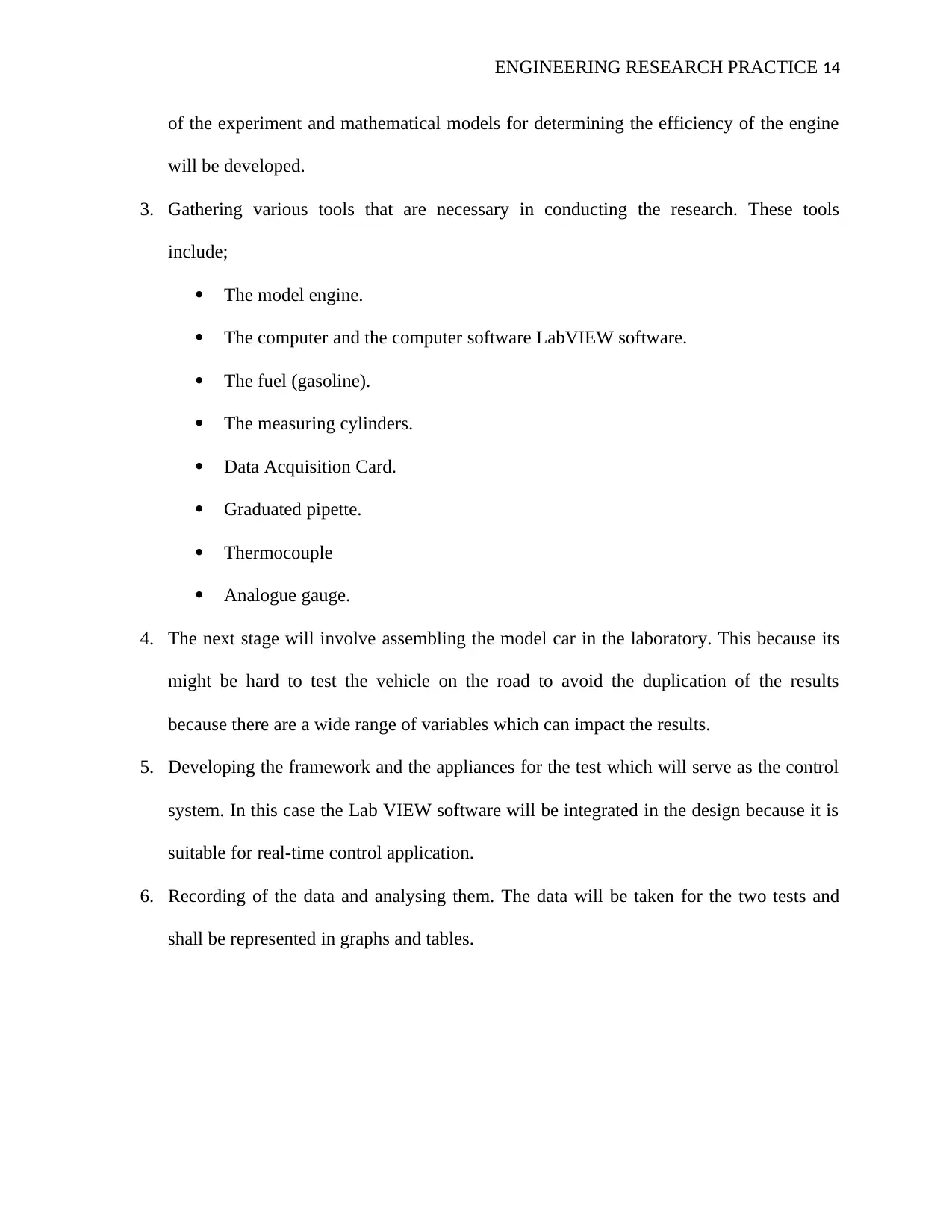
ENGINEERING RESEARCH PRACTICE 14
of the experiment and mathematical models for determining the efficiency of the engine
will be developed.
3. Gathering various tools that are necessary in conducting the research. These tools
include;
The model engine.
The computer and the computer software LabVIEW software.
The fuel (gasoline).
The measuring cylinders.
Data Acquisition Card.
Graduated pipette.
Thermocouple
Analogue gauge.
4. The next stage will involve assembling the model car in the laboratory. This because its
might be hard to test the vehicle on the road to avoid the duplication of the results
because there are a wide range of variables which can impact the results.
5. Developing the framework and the appliances for the test which will serve as the control
system. In this case the Lab VIEW software will be integrated in the design because it is
suitable for real-time control application.
6. Recording of the data and analysing them. The data will be taken for the two tests and
shall be represented in graphs and tables.
of the experiment and mathematical models for determining the efficiency of the engine
will be developed.
3. Gathering various tools that are necessary in conducting the research. These tools
include;
The model engine.
The computer and the computer software LabVIEW software.
The fuel (gasoline).
The measuring cylinders.
Data Acquisition Card.
Graduated pipette.
Thermocouple
Analogue gauge.
4. The next stage will involve assembling the model car in the laboratory. This because its
might be hard to test the vehicle on the road to avoid the duplication of the results
because there are a wide range of variables which can impact the results.
5. Developing the framework and the appliances for the test which will serve as the control
system. In this case the Lab VIEW software will be integrated in the design because it is
suitable for real-time control application.
6. Recording of the data and analysing them. The data will be taken for the two tests and
shall be represented in graphs and tables.
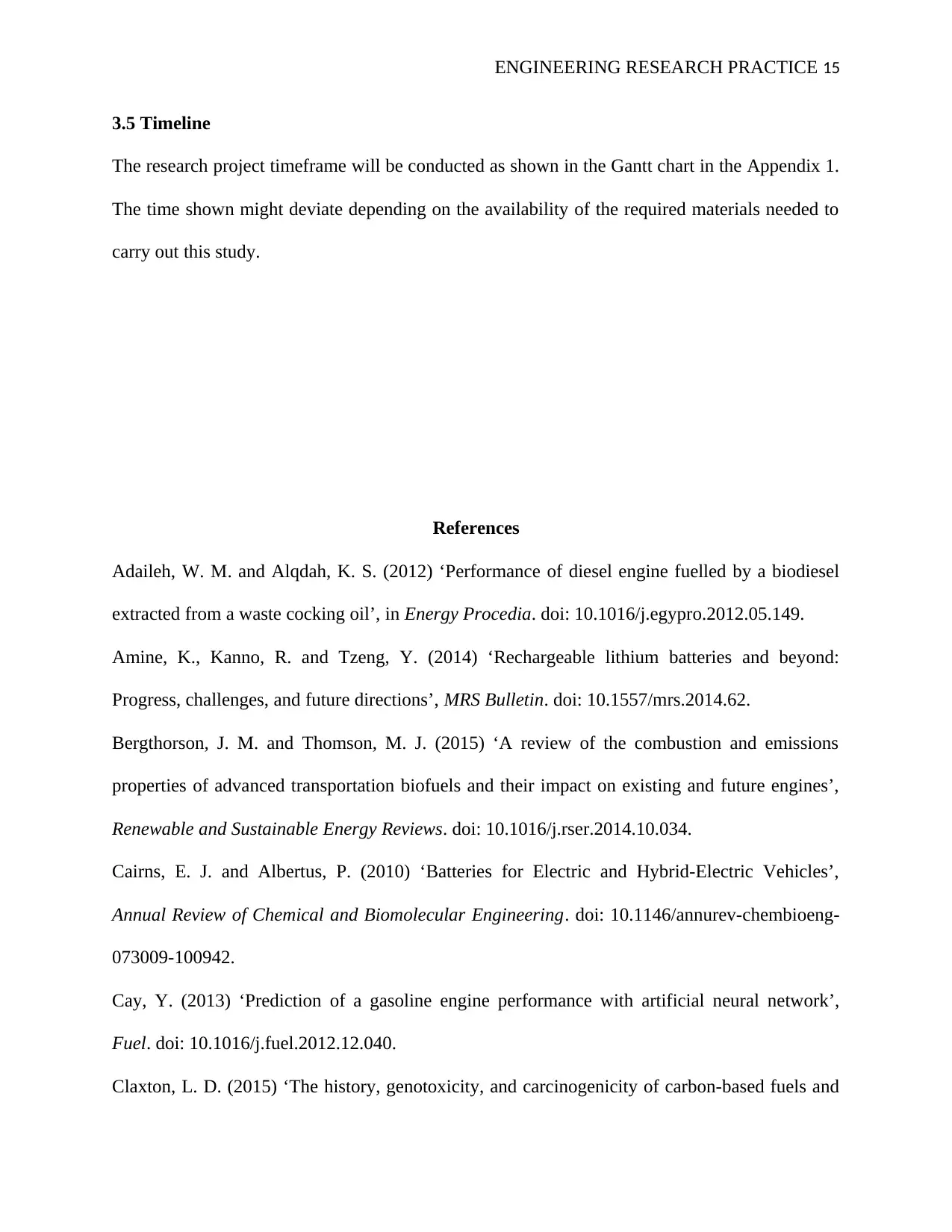
ENGINEERING RESEARCH PRACTICE 15
3.5 Timeline
The research project timeframe will be conducted as shown in the Gantt chart in the Appendix 1.
The time shown might deviate depending on the availability of the required materials needed to
carry out this study.
References
Adaileh, W. M. and Alqdah, K. S. (2012) ‘Performance of diesel engine fuelled by a biodiesel
extracted from a waste cocking oil’, in Energy Procedia. doi: 10.1016/j.egypro.2012.05.149.
Amine, K., Kanno, R. and Tzeng, Y. (2014) ‘Rechargeable lithium batteries and beyond:
Progress, challenges, and future directions’, MRS Bulletin. doi: 10.1557/mrs.2014.62.
Bergthorson, J. M. and Thomson, M. J. (2015) ‘A review of the combustion and emissions
properties of advanced transportation biofuels and their impact on existing and future engines’,
Renewable and Sustainable Energy Reviews. doi: 10.1016/j.rser.2014.10.034.
Cairns, E. J. and Albertus, P. (2010) ‘Batteries for Electric and Hybrid-Electric Vehicles’,
Annual Review of Chemical and Biomolecular Engineering. doi: 10.1146/annurev-chembioeng-
073009-100942.
Cay, Y. (2013) ‘Prediction of a gasoline engine performance with artificial neural network’,
Fuel. doi: 10.1016/j.fuel.2012.12.040.
Claxton, L. D. (2015) ‘The history, genotoxicity, and carcinogenicity of carbon-based fuels and
3.5 Timeline
The research project timeframe will be conducted as shown in the Gantt chart in the Appendix 1.
The time shown might deviate depending on the availability of the required materials needed to
carry out this study.
References
Adaileh, W. M. and Alqdah, K. S. (2012) ‘Performance of diesel engine fuelled by a biodiesel
extracted from a waste cocking oil’, in Energy Procedia. doi: 10.1016/j.egypro.2012.05.149.
Amine, K., Kanno, R. and Tzeng, Y. (2014) ‘Rechargeable lithium batteries and beyond:
Progress, challenges, and future directions’, MRS Bulletin. doi: 10.1557/mrs.2014.62.
Bergthorson, J. M. and Thomson, M. J. (2015) ‘A review of the combustion and emissions
properties of advanced transportation biofuels and their impact on existing and future engines’,
Renewable and Sustainable Energy Reviews. doi: 10.1016/j.rser.2014.10.034.
Cairns, E. J. and Albertus, P. (2010) ‘Batteries for Electric and Hybrid-Electric Vehicles’,
Annual Review of Chemical and Biomolecular Engineering. doi: 10.1146/annurev-chembioeng-
073009-100942.
Cay, Y. (2013) ‘Prediction of a gasoline engine performance with artificial neural network’,
Fuel. doi: 10.1016/j.fuel.2012.12.040.
Claxton, L. D. (2015) ‘The history, genotoxicity, and carcinogenicity of carbon-based fuels and

ENGINEERING RESEARCH PRACTICE 16
their emissions. Part 3: Diesel and gasoline’, Mutation Research - Reviews in Mutation Research.
doi: 10.1016/j.mrrev.2014.09.002.
Clement, K., Haesen, E. and Driesen, J. (2009) ‘Coordinated charging of multiple plug-in hybrid
electric vehicles in residential distribution grids’, in 2009 IEEE/PES Power Systems Conference
and Exposition, PSCE 2009. doi: 10.1109/PSCE.2009.4839973.
Curley, T. M. (2011) ‘America’, in Samuel Johnson in Context. doi:
10.1017/CBO9781139047852.016.
Dunn, B., Kamath, H. and Tarascon, J. M. (2011) ‘Electrical energy storage for the grid: A
battery of choices’, Science. doi: 10.1126/science.1212741.
Dwivedi, G., Jain, S. and Sharma, M. P. (2011) ‘Impact analysis of biodiesel on engine
performance - A review’, Renewable and Sustainable Energy Reviews. doi:
10.1016/j.rser.2011.07.089.
Eberle, U. and Von Helmolt, R. (2010) ‘Sustainable transportation based on electric vehicle
concepts: A brief overview’, Energy and Environmental Science. doi: 10.1039/c001674h.
Fang, L. et al. (2012) ‘Optimal control of parallel hybrid electric vehicles’, in Proceedings of the
2012 7th IEEE Conference on Industrial Electronics and Applications, ICIEA 2012. doi:
10.1109/ICIEA.2012.6360764.
Goodenough, J. B. (2014) ‘Electrochemical energy storage in a sustainable modern society’,
Energy and Environmental Science. doi: 10.1039/c3ee42613k.
Goodenough, J. B. and Kim, Y. (2011) ‘Challenges for rechargeable batteries’, Journal of Power
Sources. doi: 10.1016/j.jpowsour.2010.11.074.
Hassan, M. H. and Kalam, M. A. (2013) ‘An overview of biofuel as a renewable energy source:
Development and challenges’, in Procedia Engineering. doi: 10.1016/j.proeng.2013.03.087.
their emissions. Part 3: Diesel and gasoline’, Mutation Research - Reviews in Mutation Research.
doi: 10.1016/j.mrrev.2014.09.002.
Clement, K., Haesen, E. and Driesen, J. (2009) ‘Coordinated charging of multiple plug-in hybrid
electric vehicles in residential distribution grids’, in 2009 IEEE/PES Power Systems Conference
and Exposition, PSCE 2009. doi: 10.1109/PSCE.2009.4839973.
Curley, T. M. (2011) ‘America’, in Samuel Johnson in Context. doi:
10.1017/CBO9781139047852.016.
Dunn, B., Kamath, H. and Tarascon, J. M. (2011) ‘Electrical energy storage for the grid: A
battery of choices’, Science. doi: 10.1126/science.1212741.
Dwivedi, G., Jain, S. and Sharma, M. P. (2011) ‘Impact analysis of biodiesel on engine
performance - A review’, Renewable and Sustainable Energy Reviews. doi:
10.1016/j.rser.2011.07.089.
Eberle, U. and Von Helmolt, R. (2010) ‘Sustainable transportation based on electric vehicle
concepts: A brief overview’, Energy and Environmental Science. doi: 10.1039/c001674h.
Fang, L. et al. (2012) ‘Optimal control of parallel hybrid electric vehicles’, in Proceedings of the
2012 7th IEEE Conference on Industrial Electronics and Applications, ICIEA 2012. doi:
10.1109/ICIEA.2012.6360764.
Goodenough, J. B. (2014) ‘Electrochemical energy storage in a sustainable modern society’,
Energy and Environmental Science. doi: 10.1039/c3ee42613k.
Goodenough, J. B. and Kim, Y. (2011) ‘Challenges for rechargeable batteries’, Journal of Power
Sources. doi: 10.1016/j.jpowsour.2010.11.074.
Hassan, M. H. and Kalam, M. A. (2013) ‘An overview of biofuel as a renewable energy source:
Development and challenges’, in Procedia Engineering. doi: 10.1016/j.proeng.2013.03.087.
Secure Best Marks with AI Grader
Need help grading? Try our AI Grader for instant feedback on your assignments.
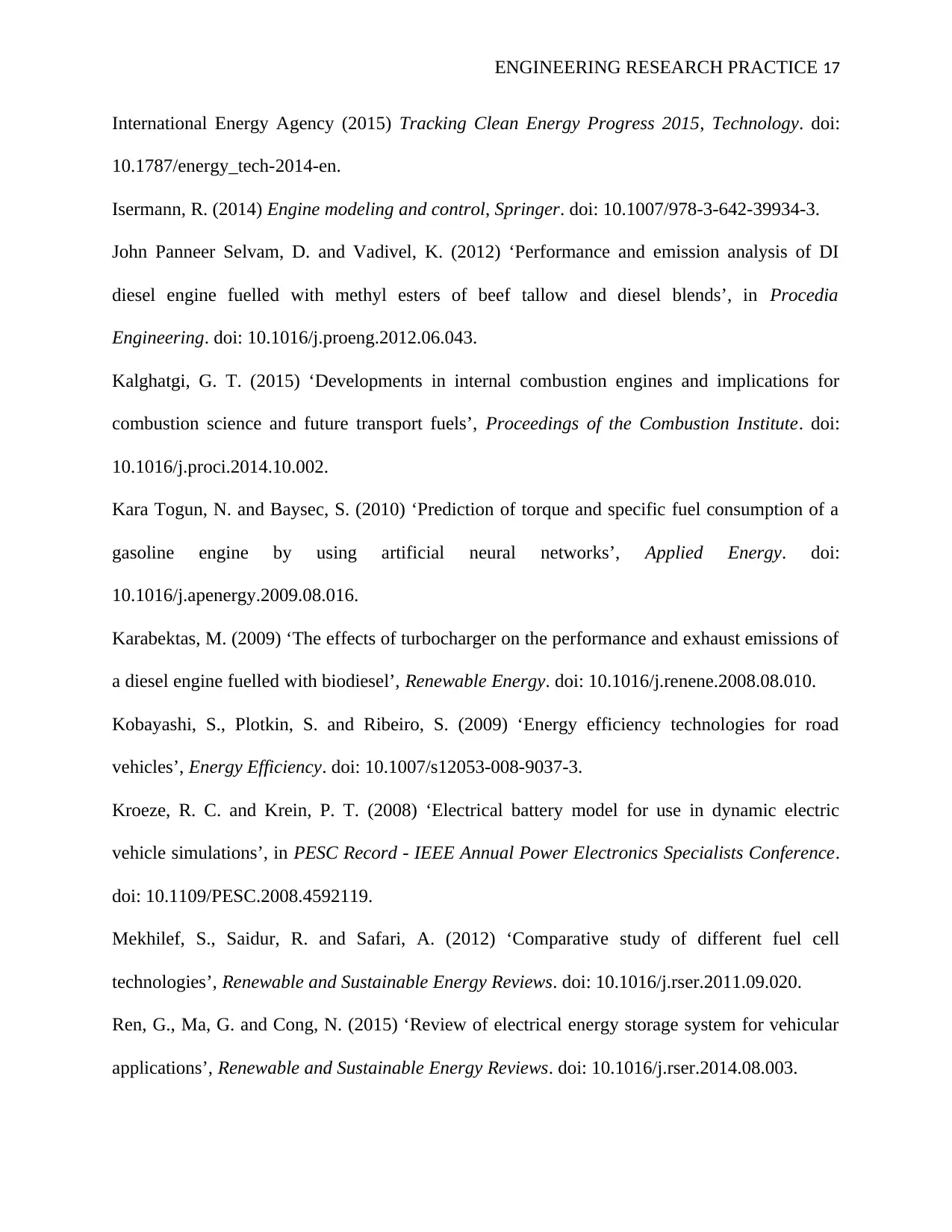
ENGINEERING RESEARCH PRACTICE 17
International Energy Agency (2015) Tracking Clean Energy Progress 2015, Technology. doi:
10.1787/energy_tech-2014-en.
Isermann, R. (2014) Engine modeling and control, Springer. doi: 10.1007/978-3-642-39934-3.
John Panneer Selvam, D. and Vadivel, K. (2012) ‘Performance and emission analysis of DI
diesel engine fuelled with methyl esters of beef tallow and diesel blends’, in Procedia
Engineering. doi: 10.1016/j.proeng.2012.06.043.
Kalghatgi, G. T. (2015) ‘Developments in internal combustion engines and implications for
combustion science and future transport fuels’, Proceedings of the Combustion Institute. doi:
10.1016/j.proci.2014.10.002.
Kara Togun, N. and Baysec, S. (2010) ‘Prediction of torque and specific fuel consumption of a
gasoline engine by using artificial neural networks’, Applied Energy. doi:
10.1016/j.apenergy.2009.08.016.
Karabektas, M. (2009) ‘The effects of turbocharger on the performance and exhaust emissions of
a diesel engine fuelled with biodiesel’, Renewable Energy. doi: 10.1016/j.renene.2008.08.010.
Kobayashi, S., Plotkin, S. and Ribeiro, S. (2009) ‘Energy efficiency technologies for road
vehicles’, Energy Efficiency. doi: 10.1007/s12053-008-9037-3.
Kroeze, R. C. and Krein, P. T. (2008) ‘Electrical battery model for use in dynamic electric
vehicle simulations’, in PESC Record - IEEE Annual Power Electronics Specialists Conference.
doi: 10.1109/PESC.2008.4592119.
Mekhilef, S., Saidur, R. and Safari, A. (2012) ‘Comparative study of different fuel cell
technologies’, Renewable and Sustainable Energy Reviews. doi: 10.1016/j.rser.2011.09.020.
Ren, G., Ma, G. and Cong, N. (2015) ‘Review of electrical energy storage system for vehicular
applications’, Renewable and Sustainable Energy Reviews. doi: 10.1016/j.rser.2014.08.003.
International Energy Agency (2015) Tracking Clean Energy Progress 2015, Technology. doi:
10.1787/energy_tech-2014-en.
Isermann, R. (2014) Engine modeling and control, Springer. doi: 10.1007/978-3-642-39934-3.
John Panneer Selvam, D. and Vadivel, K. (2012) ‘Performance and emission analysis of DI
diesel engine fuelled with methyl esters of beef tallow and diesel blends’, in Procedia
Engineering. doi: 10.1016/j.proeng.2012.06.043.
Kalghatgi, G. T. (2015) ‘Developments in internal combustion engines and implications for
combustion science and future transport fuels’, Proceedings of the Combustion Institute. doi:
10.1016/j.proci.2014.10.002.
Kara Togun, N. and Baysec, S. (2010) ‘Prediction of torque and specific fuel consumption of a
gasoline engine by using artificial neural networks’, Applied Energy. doi:
10.1016/j.apenergy.2009.08.016.
Karabektas, M. (2009) ‘The effects of turbocharger on the performance and exhaust emissions of
a diesel engine fuelled with biodiesel’, Renewable Energy. doi: 10.1016/j.renene.2008.08.010.
Kobayashi, S., Plotkin, S. and Ribeiro, S. (2009) ‘Energy efficiency technologies for road
vehicles’, Energy Efficiency. doi: 10.1007/s12053-008-9037-3.
Kroeze, R. C. and Krein, P. T. (2008) ‘Electrical battery model for use in dynamic electric
vehicle simulations’, in PESC Record - IEEE Annual Power Electronics Specialists Conference.
doi: 10.1109/PESC.2008.4592119.
Mekhilef, S., Saidur, R. and Safari, A. (2012) ‘Comparative study of different fuel cell
technologies’, Renewable and Sustainable Energy Reviews. doi: 10.1016/j.rser.2011.09.020.
Ren, G., Ma, G. and Cong, N. (2015) ‘Review of electrical energy storage system for vehicular
applications’, Renewable and Sustainable Energy Reviews. doi: 10.1016/j.rser.2014.08.003.
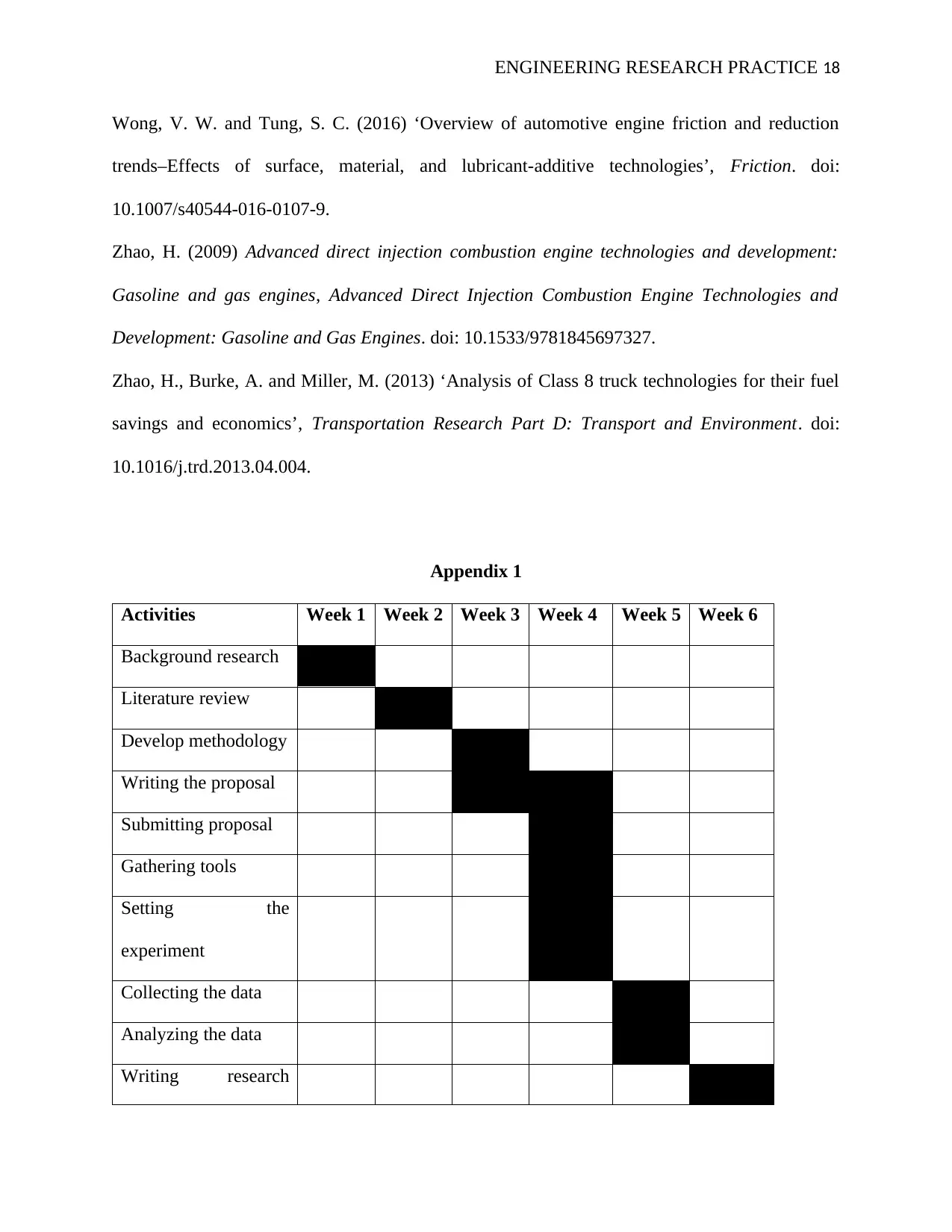
ENGINEERING RESEARCH PRACTICE 18
Wong, V. W. and Tung, S. C. (2016) ‘Overview of automotive engine friction and reduction
trends–Effects of surface, material, and lubricant-additive technologies’, Friction. doi:
10.1007/s40544-016-0107-9.
Zhao, H. (2009) Advanced direct injection combustion engine technologies and development:
Gasoline and gas engines, Advanced Direct Injection Combustion Engine Technologies and
Development: Gasoline and Gas Engines. doi: 10.1533/9781845697327.
Zhao, H., Burke, A. and Miller, M. (2013) ‘Analysis of Class 8 truck technologies for their fuel
savings and economics’, Transportation Research Part D: Transport and Environment. doi:
10.1016/j.trd.2013.04.004.
Appendix 1
Activities Week 1 Week 2 Week 3 Week 4 Week 5 Week 6
Background research
Literature review
Develop methodology
Writing the proposal
Submitting proposal
Gathering tools
Setting the
experiment
Collecting the data
Analyzing the data
Writing research
Wong, V. W. and Tung, S. C. (2016) ‘Overview of automotive engine friction and reduction
trends–Effects of surface, material, and lubricant-additive technologies’, Friction. doi:
10.1007/s40544-016-0107-9.
Zhao, H. (2009) Advanced direct injection combustion engine technologies and development:
Gasoline and gas engines, Advanced Direct Injection Combustion Engine Technologies and
Development: Gasoline and Gas Engines. doi: 10.1533/9781845697327.
Zhao, H., Burke, A. and Miller, M. (2013) ‘Analysis of Class 8 truck technologies for their fuel
savings and economics’, Transportation Research Part D: Transport and Environment. doi:
10.1016/j.trd.2013.04.004.
Appendix 1
Activities Week 1 Week 2 Week 3 Week 4 Week 5 Week 6
Background research
Literature review
Develop methodology
Writing the proposal
Submitting proposal
Gathering tools
Setting the
experiment
Collecting the data
Analyzing the data
Writing research

ENGINEERING RESEARCH PRACTICE 19
report
Submitting the report
report
Submitting the report
1 out of 19
Related Documents
Your All-in-One AI-Powered Toolkit for Academic Success.
+13062052269
info@desklib.com
Available 24*7 on WhatsApp / Email
![[object Object]](/_next/static/media/star-bottom.7253800d.svg)
Unlock your academic potential
© 2024 | Zucol Services PVT LTD | All rights reserved.





